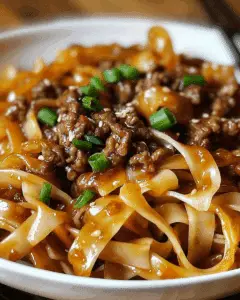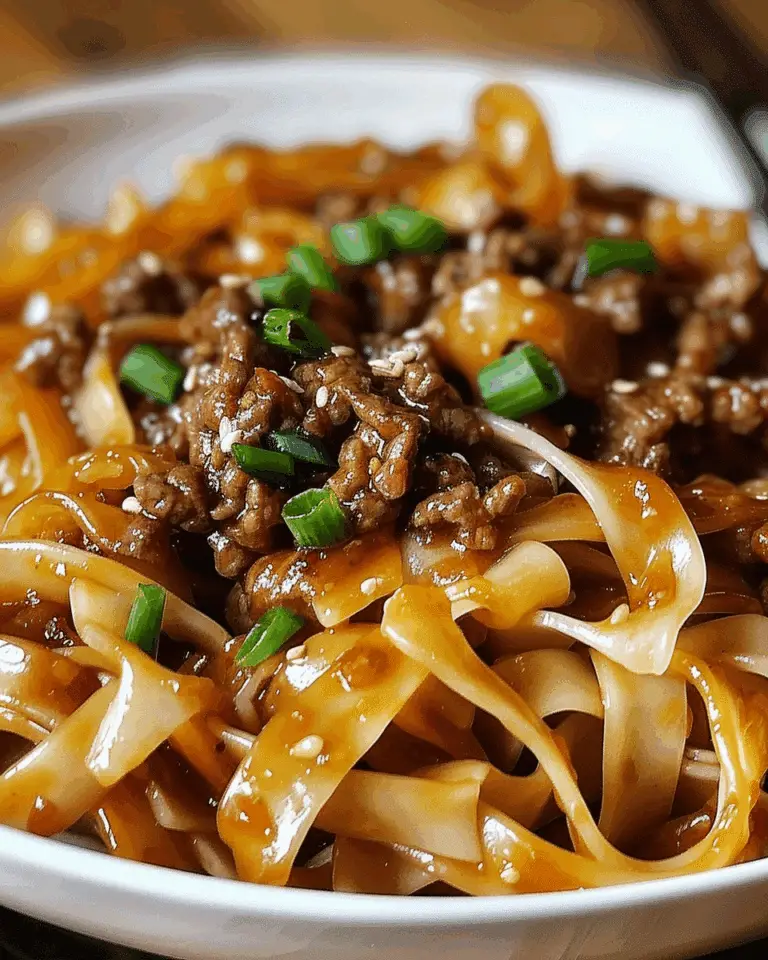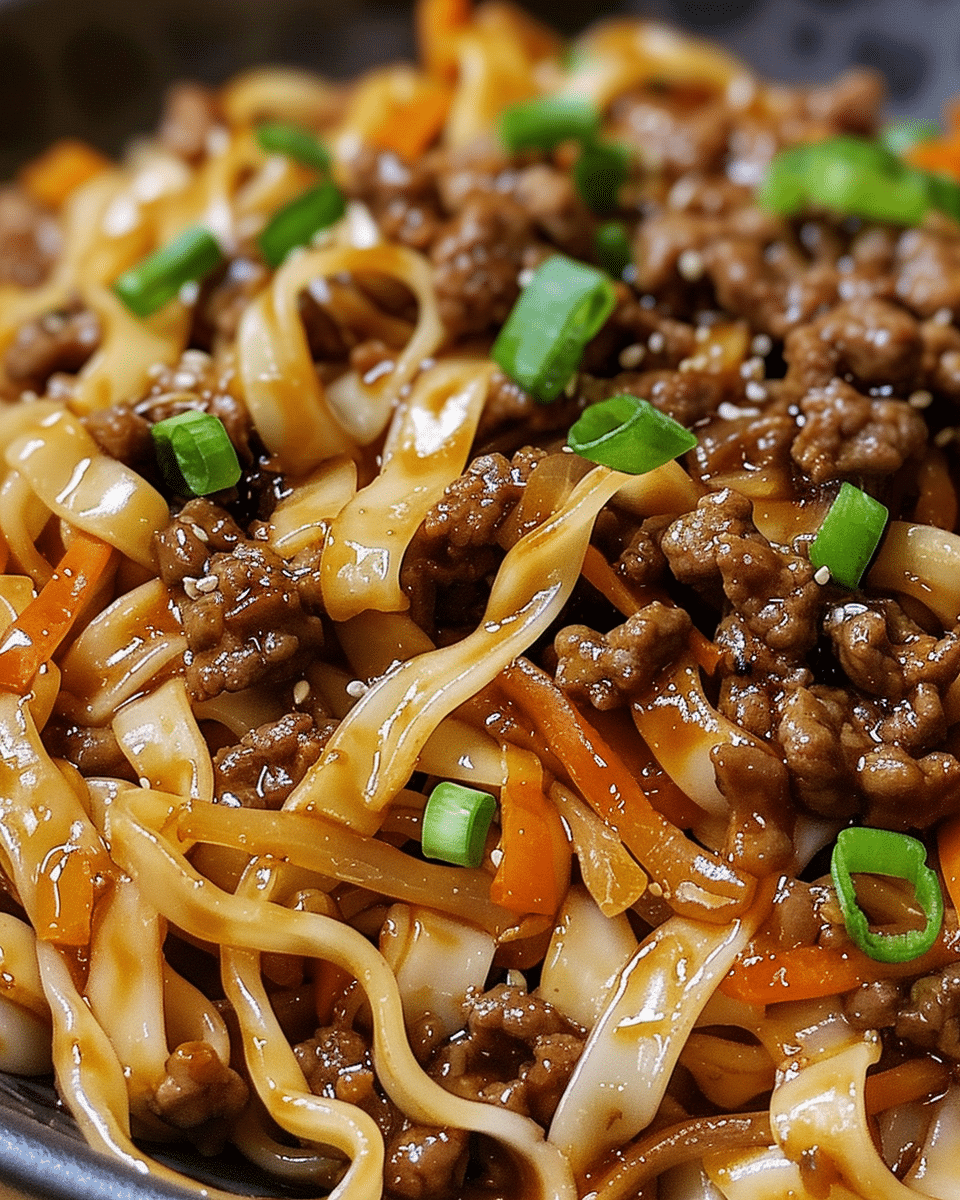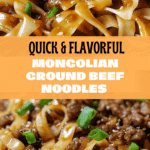A deliciously savory Asian-inspired dish that combines juicy ground beef with a sweet and tangy sauce over tender noodles. This Mongolian Ground Beef Noodles recipe delivers all the flavors of your favorite takeout but comes together in just 20 minutes, making it perfect for busy weeknights when you need a satisfying meal with minimal effort.
Why You’ll Love This Recipe
This Mongolian Ground Beef Noodles recipe will quickly become a family favorite for several reasons. First, it’s incredibly quick to prepare—ready in just 20 minutes from start to finish. The flavor profile offers the perfect balance of sweet, savory, and umami notes that will satisfy even picky eaters. Using ground beef makes this dish more affordable than traditional Mongolian beef recipes that call for steak, while still delivering excellent flavor. The simple ingredients are likely already in your pantry, eliminating the need for a special shopping trip. Finally, it’s a versatile dish that can be easily modified to suit your taste preferences or dietary needs.
Ingredients
(Tip: You’ll find the full list of ingredients and measurements in the recipe card below.)
Ground beef serves as the protein foundation for this dish, providing rich flavor and satisfying texture. Choose a lean ground beef (85/15 or 90/10) for the best results with less excess fat.
Sesame oil is essential for authentic Asian flavor, imparting a distinctive nutty aroma and taste that elevates the entire dish. A little goes a long way, so don’t be tempted to add more than the recipe suggests.
Garlic adds aromatic depth and complexity to the sauce. Fresh minced garlic offers the best flavor, but pre-minced garlic from a jar works in a pinch if you’re short on time.
Ginger brings a warm, slightly spicy brightness that’s characteristic of Asian cuisine. Fresh grated ginger provides the most vibrant flavor, though ground ginger can be substituted at a ratio of ¼ teaspoon ground to 1 teaspoon fresh.
Soy sauce contributes the essential salty, umami foundation for the sauce. Low-sodium varieties work well if you’re watching your salt intake, and tamari makes an excellent gluten-free alternative.
Hoisin sauce adds complexity with its sweet and savory profile, often described as Chinese barbecue sauce. This thick, fragrant sauce helps create the signature Mongolian flavor.
Brown sugar balances the saltiness with necessary sweetness and helps create the glossy caramelization characteristic of Mongolian beef dishes. Light or dark brown sugar both work well here.
Noodles provide the hearty, satisfying base that completes this meal. The recipe is flexible, working beautifully with ramen, spaghetti, lo mein, or rice noodles based on your preference.
Green onions offer a fresh, mild onion flavor and vibrant color contrast as a garnish. Both the white and green parts can be used, with the greens adding a pop of color to the finished dish.
Directions
- Heat sesame oil in a large skillet over medium heat. Add ground beef and cook until browned.
- Add garlic and ginger, sautéing for 1 minute until fragrant.
- Stir in soy sauce, hoisin sauce, and brown sugar. Simmer for 2-3 minutes until the sauce thickens.
- Toss in the cooked noodles and stir to coat in the sauce.
- Top with chopped green onions and serve immediately.
Servings and Timing
This recipe yields 4 generous servings, making it perfect for a family dinner. Each serving contains approximately 400 calories. The dish comes together in just 20 minutes total—10 minutes for preparation and 10 minutes for cooking. This efficiency makes it an ideal weeknight meal option when time is limited but you still want something delicious and satisfying.
Variations
Spicy Mongolian Beef Noodles: Add 1-2 teaspoons of sriracha or 1/2 teaspoon of red pepper flakes to the sauce for a spicy kick.
Vegetable-Packed Version: Add 2 cups of mixed vegetables like bell peppers, broccoli, snap peas, or carrots. Sauté them briefly after cooking the beef but before adding the sauce.
Vegetarian Alternative: Substitute the ground beef with 16 ounces of crumbled firm tofu or a plant-based ground meat alternative.
Gluten-Free Option: Use tamari instead of soy sauce and serve over rice noodles or zucchini noodles instead of wheat-based pasta.
Low-Carb Version: Replace the noodles with spiralized zucchini or cabbage for a lighter meal with fewer carbohydrates.
Mongolian Ground Turkey: Substitute ground turkey for a leaner protein option. You may want to add an extra teaspoon of sesame oil since turkey has less fat than beef.
Storage/Reheating
Refrigeration: Store leftover Mongolian Ground Beef Noodles in an airtight container in the refrigerator for up to 3-4 days. The flavors often deepen after a day, making leftovers particularly delicious.
Freezing: While you can freeze this dish, the noodles may change texture upon thawing. For best results, consider freezing just the meat and sauce separately from noodles. Freeze in airtight containers or freezer bags for up to 2-3 months.
Reheating: To reheat refrigerated leftovers, microwave on high for 1-2 minutes, stirring halfway through. Alternatively, reheat in a skillet over medium heat, adding a splash of water or beef broth if the noodles seem dry. For frozen portions, thaw overnight in the refrigerator before reheating.
Make-Ahead Tips: You can prepare the beef and sauce up to 2 days ahead, then simply cook fresh noodles and combine when ready to serve.

FAQs
What type of noodles work best for Mongolian Ground Beef Noodles?
While the recipe suggests ramen or spaghetti, any medium-thickness noodle works well. Lo mein, udon, rice noodles, or even fettuccine are excellent choices. The key is to cook them just until al dente, as they’ll continue softening slightly when tossed with the hot sauce.
Can I make this recipe ahead of time?
Yes, though it’s best to prepare the beef mixture and noodles separately if making ahead. Store the beef mixture in the refrigerator for up to 3 days, then cook fresh noodles when ready to serve. Combine and reheat gently for best results.
How can I make this recipe healthier?
Several modifications can make this dish healthier: use 90% lean ground beef or substitute ground turkey, reduce the brown sugar by half, use low-sodium soy sauce, add extra vegetables like bell peppers or broccoli, and choose whole wheat or vegetable noodles instead of refined ones.
Is Mongolian beef actually from Mongolia?
Despite its name, Mongolian beef is not a traditional Mongolian dish. It’s an Americanized Chinese creation that became popular in Chinese-American restaurants. The dish has little connection to authentic Mongolian cuisine, which typically features lamb and limited spices.
Can I substitute the hoisin sauce with something else?
If you don’t have hoisin sauce, you can make a quick substitute by mixing 1 tablespoon of soy sauce with 1 teaspoon of peanut butter and 1/2 teaspoon each of molasses (or honey) and sriracha or hot sauce. Alternatively, oyster sauce can work as a substitute, though it will create a slightly different flavor profile.
How do I know when the ground beef is properly cooked?
Ground beef is properly cooked when it’s no longer pink and has reached an internal temperature of 160°F (71°C). Break up the meat while cooking to ensure it browns evenly and drain excess fat if necessary before adding the other ingredients.
Can I add vegetables to this recipe?
Absolutely! This dish works wonderfully with added vegetables. Bell peppers, broccoli, carrots, snow peas, or mushrooms all make excellent additions. Add firmer vegetables after browning the beef and softer ones just before adding the sauce.
Why is my sauce too thin?
If your sauce seems too thin, continue simmering it for a few more minutes to reduce and thicken. Alternatively, mix 1 teaspoon of cornstarch with 1 tablespoon of cold water and stir this slurry into the sauce to thicken it more quickly.
Is this recipe spicy?
As written, this recipe is not spicy. It has a sweet-savory flavor profile that’s appealing to most palates, including children. To add heat, incorporate red pepper flakes, sriracha, or sliced fresh chilies according to your spice preference.
Conclusion
Mongolian Ground Beef Noodles offers the perfect solution when you’re craving the bold flavors of Asian takeout but want something homemade, affordable, and quick. This 20-minute meal delivers the perfect balance of savory, sweet, and umami flavors in a family-friendly format that’s adaptable to various dietary needs and preferences. Whether you’re serving it as written or customizing it with additional vegetables or alternative proteins, this versatile recipe earns its place in your regular meal rotation. With simple ingredients and straightforward preparation, it’s accessible even to novice cooks while still impressive enough for dinner guests. Make it once, and you’ll understand why this modern take on a takeout classic continues to be a household favorite.
Print
Ground Beef Noodles
A quick and flavorful Mongolian ground beef noodle dish with a savory sauce, perfect for a quick weeknight dinner.
- Total Time: 20 minutes
- Yield: 4 servings
Ingredients
- 1 lb ground beef
- 1 tablespoon sesame oil
- 3 cloves garlic, minced
- 2 teaspoons ginger, grated
- 1/4 cup soy sauce
- 1 tablespoon hoisin sauce
- 1 tablespoon brown sugar
- 2 cups cooked noodles (such as ramen or spaghetti)
- 2 green onions, chopped
Instructions
- Heat sesame oil in a large skillet over medium heat. Add ground beef and cook until browned.
- Add garlic and ginger, sautéing for 1 minute until fragrant.
- Stir in soy sauce, hoisin sauce, and brown sugar. Simmer for 2-3 minutes until the sauce thickens.
- Toss in the cooked noodles and stir to coat in the sauce.
- Top with chopped green onions and serve immediately.
Notes
- You can substitute ramen or spaghetti noodles with any type of noodle you prefer.
- Add vegetables like bell peppers or broccoli for extra nutrition and texture.
- Prep Time: 10 minutes
- Cook Time: 10 minutes
- Category: Main Course
- Method: Stovetop
- Cuisine: Asian
- Diet: Halal
Nutrition
- Serving Size: 1 serving
- Calories: 400 kcal
- Sugar: 6 g
- Sodium: 700 mg
- Fat: 14 g
- Saturated Fat: 5 g
- Unsaturated Fat: 9 g
- Trans Fat: 0 g
- Carbohydrates: 45 g
- Fiber: 2 g
- Protein: 22 g
- Cholesterol: 55 mg


